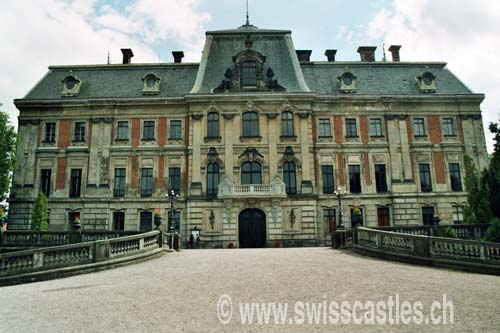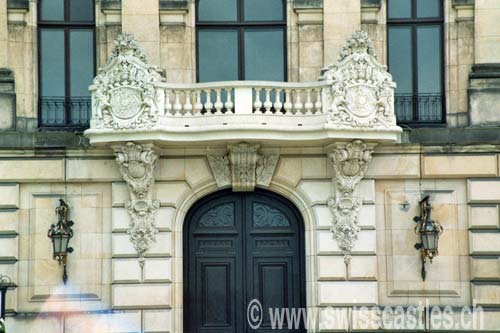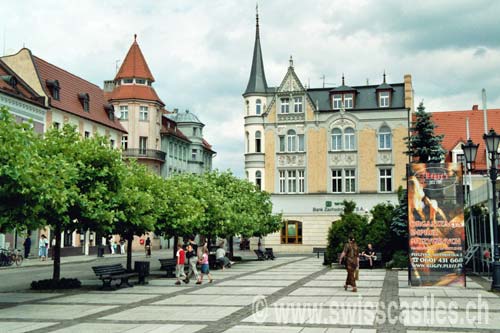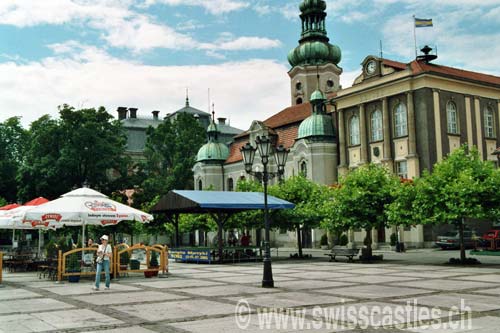Notre voyage en mobilhome se poursuit par quelques jours en Pologne. La douane entre la République tchèque et la Pologne est franchie sans aucune difficulté. Notre premier arrêt sera Pszczyna. Passage dans un bureau de change pour obtenir des zlotis.
Pszczyna est une petite ville frontière avec un grand château (voir historique ci-dessous en anglais).




In the immediate neighbourhood of the market square, right behind the Wybrantzen Gate, the magnificent residence of the Dukes of Pszczyna is situated. A little farther the following buildings are to be seen: the castle Outhouse, the Stables, the Riding Stables, the Coach-house, and - at the edge of the beautiful and wide landscape park - the Ludwikówka manor house.
The Castle Museum occupies a once fortified castle, with time converted into an elegant, three-wing residence. In all likelihood, the first castle in Pszczyna – according to Heinrich Schaeffer, a ducal annalist and Pszczyna chronicler who lived in the 19th century – was built in the 11th or 12th century by the Piast princes. It had been a one-wing construction, surrounded by earthworks and a moat. It served as a hunting lodge, also throughout the following centuries until the 20th century since the nearby forests, abundant in chase game, were famous for hunting parties organised in the area. It was only in the 15th century that a brick castle was built in Pszczyna by Helena Korybutówna, a niece of Wladyslaw Jagiello.
This mediaeval castle – within the centuries - was many a time rebuilt and extended. The last reconstruction – in the neo-baroque style – was carried out in the years 1871-1876, by Aleksandre Hippolite Destailleur, a famous French architect (1822-1893). Contrary to the previous works, protracted due to lack of financial resources, this reconstruction was done with a flourish and without getting into debt. In this style the castle has preserved up to these days.
The successive rulers of the castle in Pszczyna were the Piast princes of the Opole-Racibórz line, the Bohemian Premyslids of Opawa, a Hungarian family of Turzon from Spisz, a Silesian family of Promnitz from Zary, the Anhalt family from Köthen and the Hochbergs from Ksiaz. What deserves particular emphasis is the fact that Pszczyna, situated o-n the cultural borderland, has always witnessed peaceful harmony among the Polish, Czech, Hungarian and German cultures.
During the First World War, from the autumn of 1914 to February 1917, the castle housed the headquarters of the German army. Emperor William II, along with field marshal Paul Hindenburg and general Erich Ludendorff, held staff meetings during which they reached important political and military decisions of the highest historic significance.
It was here from where Arthur Zimmermann, the then minister of foreign affairs, sent a telegram meant to provoke war on the American continent. This was also the place where the decision on the total underwater war on the Atlantic was taken. Details of those events have been described by Barbara Tuchman, an American writer, in her book The Zimmermann telegram (published in Poland in 1997). Boguslaw Woloszanski, a famous Polish journalist who specialises in war issue, also referred to the events that took place in Pszczyna in his book Ten okrutny wiek (This Cruel Century) (published in Warsaw in 1995) and made a documentary (June 2000) in the Sensacje XX wieku (Sensations of the 20th century) series.
In the turbulent days of the Second World War, the castle housed various civilian and military institutions of the Nazi Germany. After the liberation of Pszczyna in February 1945, a part of the castle was transformed into a Red Army hospital. After the Soviet forces had left the building, the then authorities considered various options of its further use. Eventually, a decision to establish a museum in the castle was taken.
The museum was opened on the 9th of May 1946. Based on the preserved original interiors and a part of furniture from the Hochbergs’ times, as well as on works of art brought from other Silesian castles ruined by war, the museum presented residential interiors from the Renaissance to the late 19th century.
Many years later, actions were undertaken aimed at restoring the traditional, elegant and hunting style to the Pszczyna castle. Reconstruction of the castle interiors was commenced. These accomplishments have been noticed and recognised in Europe. In 1995, the supragovernmental organisation Europa Nostra based in the Hague, engaged in the protection of European cultural heritage and natural environment awarded the Castle Museum in Pszczyna a honorary diploma for “the careful refurbishment of the castle’s interiors and furnishings, all based on meticulous historic research, to restore the lustre of the early 20th century”. (http://www.pszczyna.pl)

